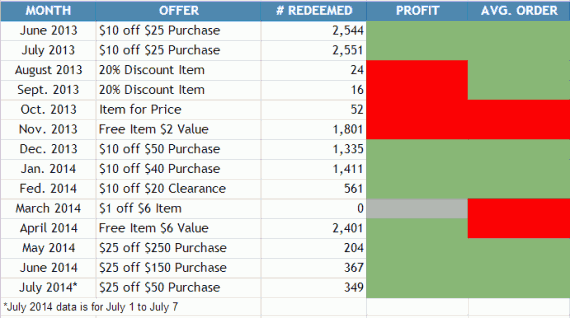Retail coupons can help merchants acquire new customers, encourage regular customers to buy more, and increase average order size. But like all forms of marketing and promotion, not all coupon marketing campaigns or tactics will perform equally.
In 2014, getting the most out of a coupon marketing campaign is really an exercise in data analysis. Begin by dividing coupon-marketing tactics into three component parts: the offer, the coupon design, and the delivery mechanism. With each part you’ll want to plan tests, analyze the results of those tests, and optimize the campaign for another test.
Analyze the Offer
To state the obvious, the coupon offer is given to the customer in exchange for redeeming the coupon. The offer is also the first thing that marketers need to measure.
Common offers include free shipping, money off (either in the form of a dollar off or percentage off), buy x get x, or external benefits like donations to an organization or a group. Here are some examples.
-
“Free shipping on any order.”
-
“Get $10 off of a $50 purchase.”
-
“Get $1 off of a particular item.”
-
“Buy one get one free.”
-
“Get an item free.”
-
“10% of your purchase will be donated to Habitat for Humanity.”
You might find that you want to know if a free shipping offer is enough to encourage new customers or if a get x off of a y purchase will spur regular shoppers to buy more.
The table below shows coupon tracking data for an integrated retailer. The retailer tested offers on a monthly basis and was able to identify which types of offers seemed to work best.

This example shows how one retailer’s coupon marketing efforts performed by offer over time.
In the table, a green bar in the profit column indicates a profitable coupon while a red bar indicates that the coupon lost money. The gray bar is a coupon that was not used even once. In all cases, the cost of the coupon and coupon delivery was deducted from the profits as was the cost of goods sold and other order-related expenses.
In the average order size column — “Avg. Order” — a green bar indicates an average order size larger than the retailer’s overall average order value, while a red bar indicates an average order size that is less than the retailer’s overall average order value.
In all cases, between 70,000 and 100,000 coupons were delivered to demographically selected potential customers.
The data leads to some very interesting insights. For example, the coupon that offered a $1 off of a particular item, which had a retail price of about $6, resulted in no redemptions. This may have been an indication that the offer was too narrow to appeal. Similarly, offers that simply gave a discount on a purchase of whatever the customer wanted ($10 off $25, $10 off $40, and similar) consistently produced a profit and an improved average order value.
In your own business, plan a consistent and sustained coupon program, monitor closely how each new offer performs, and eventually you will discover which coupon offers are the most likely to generate profits.
Optimize the Coupon Design
A second area that marketers will want to monitor, text, and optimize is the coupon design. Modern coupons can take many forms, including printed coupons, coupon codes in emails, coupon codes on coupon websites, coupons on social media sites, or even coupon codes in text messages.
Each of these formats can have an impact on coupon performance. It is important, however, to distinguish between coupon designs and coupon delivery mechanisms, which I will discuss below. To do this, it may be necessary to repeat offers, varying the design to learn how design impacts campaign success.
Looking back to the chart in the previous section, notice that the retailer ran the identical offer in December 2013 and July 2014. In December 2013, the $10 off of a $50 offer earned 1,335 redemptions, but in July 2014, which is showing data through just the 7th, the offer is on pace to have about 1,545 redemptions, or about a 15.7 percent improvement over the last time the offer ran. In both December and July, the delivery mechanism was the same. Interestingly, on the July coupon the text describing the offer was significantly larger, which may have had an impact.
In your designs, test the coupon layout, the coupon copy, and the coupon graphics, optimizing the coupon design for each particular delivery mechanism and offer.
Compare Delivery Mechanisms
Coupons can be delivered in many different ways, and it is important to test offers and designs in various delivery mechanisms.
For each means of delivering a coupon, track the offer made and keep examples of how the coupon was laid out. You are also going to want to compare delivery mechanisms against each other, for example, is email better or worse performing than a shared mail delivery or how does text compare to using a coupon site.




